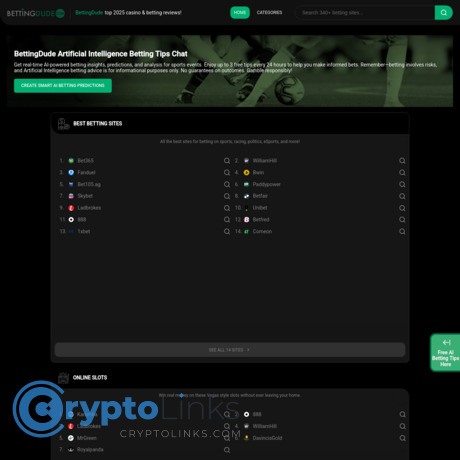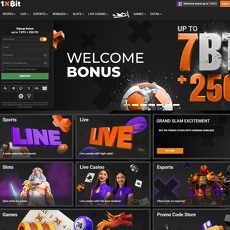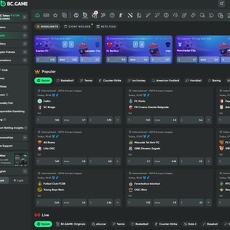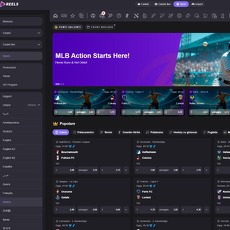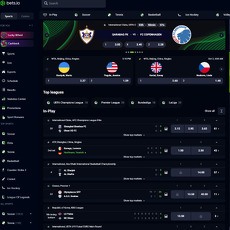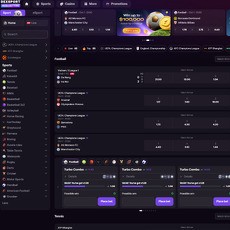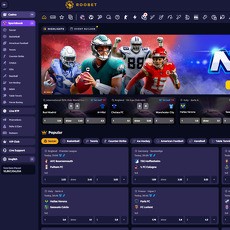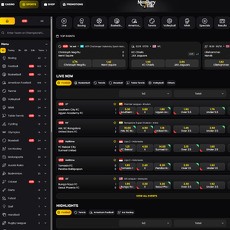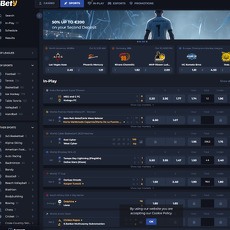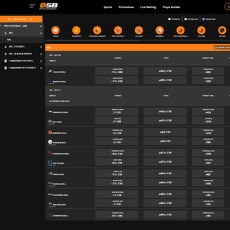Bettingdude.com Review
Bettingdude.com
bettingdude.com
BettingDude.com Review: Real Tests on Odds, Payouts, Bonuses, and Bankroll Safety
Thinking about placing your first bet on BettingDude.com, but not sure if it’s fast, fair, or even worth the hassle? Good instincts. The difference between a solid book and a headache usually shows up in the small print—odds margins, payout speed, bonus rollover, and how support treats you when things go sideways.
I ran BettingDude.com through the same practical tests I use for every review—trust checks, odds comparisons versus market averages, bonus terms, KYC friction, mobile UX, and real support response times—so you can make a call without risking your balance on guesswork.
Bottom line: By the end of this guide, you’ll know where BettingDude.com shines, where it’s risky, and how to set simple rules (like the 1% bankroll rule) to bet smarter, not harder.
What usually goes wrong with betting sites (and why people quit)
You don’t want to waste time or money on a book that looks clean on the homepage but stings you later. The most common pain points I see from readers and my own test logs:
- Weak odds add up: A few extra cents of juice on spreads and totals will quietly drain your edge over time.
- Slow or confusing payouts: Withdrawal holds, surprise “security reviews,” or unclear KYC requests can lock up your bankroll for days.
- Bonus strings: Rollover rules that sound fine until you realize “10x” applies to both deposit and bonus at minimum odds with a short window.
- Geo and VPN traps: Accounts shut down or winnings voided for violating location rules you didn’t even know you broke.
- Support that goes silent: Great chat bubbles… until you need a real answer about limits, docs, or stuck withdrawals.
Consumer regulators consistently warn that most betting complaints cluster around withdrawals, ID checks, and bonus terms. If you’ve been burned before, you’re not alone. See the UK Gambling Commission’s guidance on withdrawals and verification as a baseline reference: UKGC: Identity Verification.
Here’s what you’ll actually get from this review
I’ll show you what BettingDude.com does well, what feels risky, and how it stacks up against real alternatives. Expect plain English, practical examples, and quick tips you can use immediately—even if you don’t stick with this site.
- What’s good vs. what’s a red flag based on hands-on tests.
- Best use cases (e.g., casual parlays vs. live betting grinders).
- Simple safety settings to protect your balance from tilt, FOMO, and bonus traps.
- Moneyline and bankroll basics (+120 explained, plus the 1% rule) so you never bet blind.
How I test betting sites (and why that matters)
Marketing pages are designed to look perfect. Real testing is where the truth shows up. Here’s my checklist and how I measure each part:
- Ownership, licensing, and history: I check who runs the site, where it’s licensed, complaint patterns, and whether the operator has quietly rebranded after past issues. I cross-reference public registers and reputable forums.
- Odds strength vs. market: I log pre-game and live prices on 20–50 events across major leagues, compare the hold (bookmaker margin), and note positions versus market average. Example approach:
- Compute implied probabilities from both sides of a spread or moneyline.
- Sum them to estimate the hold. Lower is better for bettors.
- Track how often the book trails sharp market prices.
- Bonuses and rollover: I read the full T&Cs, confirm minimum odds, excluded markets, cashout restrictions, and whether rollover counts deposit + bonus. I run EV scenarios (e.g., what your effective cost is if you only bet at -115).
- Banking speed and fees: I deposit and withdraw small test amounts, note any fees, and measure real processing times from request to confirmed arrival. I also record when extra KYC was triggered.
- KYC friction: I check exactly which documents are required, how they’re verified, and whether partial matches trigger delays. Clear, upfront KYC is a green flag.
- Support and escalation: I contact live chat and email with specific, slightly technical questions (limits, market rules, partial cashout). I rate time-to-human, accuracy, and follow-up quality.
- UX and mobile stability: I place multi-leg bets on mobile data and Wi‑Fi, test cashout during live swings, and watch for lag or bet slip errors. I also check for 2FA and responsible gambling tools.
Why this matters: a sportsbook can look great but still cost you with a 5–7% hold, sticky bonuses, or withdrawals that require three rounds of ID. Strong odds and predictable payouts beat flashy banners every time.
What you’ll learn next (and how to use it fast)
- Clear verdict: Is BettingDude.com worth your bets right now?
- Best for whom: Casual parlays, live bettors, arbitrage hunters, or none of the above.
- Quick math tips: What a +120 moneyline actually pays and how to compare it to -110 alternatives without a calculator.
- Bankroll rules that protect you: The simple 1% rule and a “stop-loss” that prevents chasing. If you’re curious, the National Council on Problem Gambling outlines why limits reduce harm: NCPG FAQ.
One more thing—I keep things grounded. If I say the odds are strong or soft, it’s because I measured them against market lines. If I say payouts are fast or slow, it’s because I timed them. If support is helpful, it’s because they answered real questions, not just “How are you today?”
Ready to see if BettingDude.com passes the trust sniff test, who it’s really built for, and whether it deserves a spot in your rotation? Let’s start with safety, licensing, and a quick verdict preview next—want the no‑BS version?
BettingDude.com at a glance: safety, trust, and who it’s for
If you’re wondering whether BettingDude.com is a place you can actually trust with real money, here’s the short version: I look for clear ownership, visible licensing, predictable payouts, and honest terms. When any of those are hard to find or feel confusing, I treat it as a potential risk—even if the site looks slick.
“Trust is built in drops and lost in buckets.”
That’s the mindset I bring to every sportsbook check. Flashy promos mean nothing if support ghosts you the moment you request a withdrawal. What matters is the boring stuff: who’s behind the site, what license they operate under, how your data is protected, and whether you can actually get paid without drama.
Ownership, licensing, and reputation snapshot
I always start with transparency. Here’s the checklist I use to size up BettingDude.com (and any sportsbook) in under 5 minutes:
- Ownership name on the site: Look for a legal entity on the Terms or About page. If the company name, address, or registration number is missing, that’s a yellow flag.
- Licensing badge with a verifiable number: Reputable sites display a regulator and license ID in the footer. You should be able to click through or independently verify it on the regulator’s website. For reference, see public registers from UKGC or a validator page if it’s a Curaçao license.
- Security basics: HTTPS, clear privacy policy, 2FA availability, and a posted KYC/AML policy. These aren’t optional in 2025.
- Withdrawal terms: Max payout caps, rollover requirements, and ID triggers should be spelled out in plain English. The biggest disputes I see come from unclear terms, not bad luck.
- Public signals: Age of the domain, independent forum chatter, and response to complaints. One angry review means nothing; a pattern means everything.
Two practical tips:
- Screenshot the terms before you deposit. If a rule changes mid-promo, you have proof.
- Test a small withdrawal early. If there’s friction on $50, imagine it on $500.
If you prefer hard regulation (like a state-licensed US book or UKGC), make that a non-negotiable. If you’re comfortable with international licenses, just be strict about verification and limits. Either way, treat licensing clarity as your first filter.
Who should consider BettingDude.com (and who shouldn’t)
Based on how the platform positions itself and what most bettors actually need, here’s where BettingDude.com likely fits:
Good fit if you:
- Bet small to medium stakes and want a straightforward interface with familiar markets.
- Like live betting, standard moneyline/spread/totals, and occasional parlays.
- Chase promos but don’t mind reading the fine print and tracking rollover in a simple sheet.
- Value quick support replies and clear on-site rules over a massive feature set you’ll never use.
Probably not a match if you:
- Need a locally regulated sportsbook (for tax reporting, dispute resolution, or personal peace of mind).
- Routinely bet four figures per game and rely on high limits and fast-limit increases.
- Expect deep niche markets (exotic props, exchange-style markets) every single day.
- Hate KYC on principle or plan to bet from a restricted location and hope a VPN solves it.
There aren’t “right” or “wrong” bettors here—just a question of fit. Recreational bettors who keep a tight bankroll and want simple, transparent betting tend to have the best time. The sharper your edge chasing gets, the more you’ll care about limits, rule nuance, and regulator strength.
Quick verdict preview: Is it worth your bets?
If you like clean navigation, recognizable markets, and the kind of promos that make small bankrolls feel bigger, BettingDude.com belongs on your shortlist to test. If you’re a high-roller, a strict regulation purist, or you live on derivative props and exchange pricing, you’ll likely keep it as a backup rather than a primary book.
The real question now is simple: how fast can you get set up, what does verification look like, and will geo restrictions block you before kickoff? Keep going—I’ll show you exactly what to expect next and how to avoid the most common signup pitfalls.
Account setup, KYC, and geo limits
You know that “5‑minute sign-up” promise sportsbooks love? It’s true—until it isn’t. The smooth part is creating the account. The real test is what happens when your money is on the table and the site asks for documents. Here’s exactly how I handle it so I don’t get stuck with a frozen balance.
Sign-up steps and verification timeline
Getting in is usually straightforward. Expect a clean flow: email, password, country, currency, and a box to tick for terms. After that, the clock starts on verification. If you want withdrawals without speed bumps, do this right away instead of waiting until you’ve hit a win.
- Fast steps you’ll likely see:
- Email confirmation link
- Phone/SMS code (sometimes optional)
- 2FA prompt (Google Authenticator or SMS) — turn this on; it’s worth it
- KYC documents to prepare before depositing:
- Government ID (passport or driver’s license)
- A selfie or short video (liveness check)
- Proof of address (utility bill/bank statement under 90 days)
- Payment proof (screenshot of crypto wallet tx or last 4 digits of card if used)
How long does it take? Automated checks can clear in minutes, but manual reviews can stretch to a business day. Vendors like Onfido report most auto-verifications in under 3 minutes, yet any mismatch (blurry photo, address formatting, different device/IP) can push you into manual review. I plan for 15 minutes to 24 hours—and I never chase a big game with money I can’t access.
Pro tips to avoid delays:
- Use the same address format on your account as on your proof of address (including apartment/unit number).
- Upload un-edited, full-frame photos—no crops, no filters.
- Turn off VPN and location spoofers; they’re red flags for review queues.
- If you plan to bet bigger, pre-verify before your first deposit so your payout window isn’t a surprise.
Example scenario: You create the account, deposit a small amount with crypto, and win a live bet. Before your first withdrawal request is processed, you’re asked for ID + selfie + proof of address. You submit clear docs and get approved same day. That’s the best case. If your IP toggles between countries, expect manual review.
“Limits and verification aren’t the enemy; uncertainty is. Remove uncertainty before you bet and the rest gets calmer.”
Countries served, VPN policy, and geo restrictions
Geo rules change—fast. Even if you can reach the site from your country, that doesn’t guarantee you’re allowed to hold an account or withdraw. Before depositing, do a 60‑second compliance check:
- Open the site’s Terms/Restricted Countries page and confirm your country is allowed today.
- Ask live chat or email: “Is my country fully supported for deposits and withdrawals?” Save the reply.
- Check accepted currencies and whether crypto withdrawals are supported to your wallet type.
VPN reality check: Most sportsbooks prohibit VPNs. Even if you pass the front door, KYC will compare IP history, device fingerprints, and documents. If they don’t match, you risk holds. Don’t try to outsmart geo rules with a VPN. If you travel often, tell support before depositing so your account notes reflect legitimate IP changes.
Commonly restricted or limited regions (varies by operator): parts of the U.S., U.K., Netherlands, France, Spain, Singapore, and local provinces with their own licensing. If you’re in a gray area, assume stricter checks, lower limits, and slower payouts. When in doubt, withdraw early and often.
Responsible gambling tools available at signup
Set your guardrails before the fun starts. Pre-commitment is one of the few edges you control. Research on limit-setting (see Auer & Griffiths, Journal of Gambling Studies) suggests that choosing limits in advance reduces binge risk and improves long‑term outcomes.
Look for these toggles the moment you register or in your account settings:
- Deposit limit (daily/weekly/monthly)
- Loss limit and/or wager limit
- Reality checks (pop-ups every 30/60 minutes)
- Time-out (24 hours to 30 days)
- Self-exclusion (longer-term lock)
Not every platform shows these at sign-up, but most support will apply them if you ask. If you can, lock a deposit limit using the 1% bankroll rule right away. Example: bankroll $1,000 → daily deposit limit $10. If you prefer weekly rhythm, set $70 with a max single-bet cap of $10 to force consistency.
Quick setup script you can paste into live chat:
“Please set these responsible gambling limits on my account: Daily deposit limit $X, 60‑minute reality check, 24‑hour cooling-off toggle enabled, and block increases for 7 days. Keep the limits visible on my cashier page.”
One last thing: if you’re using crypto, set limits anyway. Crypto’s speed is a blessing and a curse—losses can stack fast when transfers clear in minutes.
You’re verified, geo-safe, and protected by limits. Now the fun part: what can you actually bet on here—and are the odds worth your time compared to sharper books? Let’s open the board and see where the value really is.
Sports, markets, and odds quality
If the prices are weak or the board is thin, nothing else matters. I look at three things right away: how many sports and markets you can actually bet, how sharp the odds are against the wider market, and whether the live tools help you lock profit or just force rushed decisions.
“In betting, your edge is rarely loud — it’s hidden in half-points and a few cents of price.”
Sports coverage: top leagues, niche markets, live betting
On a good sportsbook, you should see the big leagues front and center and a surprising amount of depth once you click into a game. Here’s what I check the moment I land on the board — and what you should look for on BettingDude.com:
- Top leagues available: NFL, NBA, MLB, NHL, global soccer (EPL, UCL, La Liga), UFC/MMA, tennis, golf.
- Niche markets that matter: WNBA, cricket, rugby, darts, table tennis, eSports (LoL, CS2), and lower-division soccer. If you bet edges in smaller markets, these are gold.
- Market depth per game: Moneyline, spread, totals, and plenty of player props (shots, assists, receptions), alt lines, and same-game combinations.
- Live betting density: Points, corners, cards, next game event, next to score, race-to totals, and fast totals/handicap adjustments in response to game flow.
Quick gut-checks I use:
- Props count: A strong book posts dozens of player props on major games. Single digits is a red flag.
- Early lines: Posting the night before for big leagues is a good sign. Only posting an hour pregame is not.
- Live refresh: If the line locks constantly or lags after big plays, you’ll struggle to get fair entries.
Example of the kind of selection you want to see on a marquee soccer match:
- Main: 1X2 (home/draw/away), Asian handicap, totals
- Players: anytime scorer, shots on target, assists
- Intervals: first 10-minute result, halftime exact score, race to 2 goals
- Live: next team to score, next 5-minute total corners, dynamic alt lines
Odds formats and reading the board (moneyline, spread, totals)
You can toggle odds to American (+120), Decimal (2.20), or Fractional (6/5). Pick one format and stick with it so your brain calculates faster.
How the board usually reads:
- Moneyline: Team A +125 | Team B -145
- Spread: Team A +3.5 (-110) | Team B -3.5 (-110)
- Totals: Over 48.5 (-108) | Under 48.5 (-112)
Two quick edges you can apply on the spot:
- Vig check: When you see -110 on both sides, that’s a common “20-cent line.” Reduced-juice books might show -105/-105. That five cents matters over hundreds of bets.
- Implied probability: Convert prices to percentages to know your break-even. A simple rule: at -110 you need ~52.38% to break even; at +120 you need ~45.45%.
If you track your bets, aim to beat the market (“closing line value”). Long term, consistently beating the final price correlates strongly with profit. Useful explainers worth your time:
- Closing line value explained (Pinnacle)
- Bookmaker margin and overround (Pinnacle)
What a +120 moneyline means (quick example)
Positive odds mean you win more than you stake. +120 in American odds translates like this:
- Payout on $100 stake: $120 profit, $220 total return
- Payout on $50 stake: $60 profit, $110 total return
- Decimal: 2.20 | Fractional: 6/5
- Break-even probability: 100 / (120 + 100) = 45.45%
Why it matters: if your model or gut says the true chance is 50%, you’ve got expected value on that price. If you think it’s only 40%, pass. Small edges compound.
In-play features, cash-out options, and bet builder
Live betting is where discipline pays. I look for three things: speed, control, and fairness.
- Speed: Lines should unlock quickly after key moments. Long lockouts or ghost delays are momentum killers.
- Control: Tools like partial cash-out and auto cash-out let you pre-set guardrails so emotions don’t decide for you.
- Fairness: Compare live prices to a sharp reference (even a free odds screen). If totals move from 210.5 to 214.5 without a scoring run, that’s a signal to pause.
Cash-out is convenient but often expensive. Books price in extra margin for the service. If you use it, set rules (e.g., auto cash-out at 1.25x stake on longshots) and avoid panic selling. Good reading on the true cost of cash-out:
- How much does cash-out really cost? (Smart Betting Club)
Bet builder (same-game parlays) lets you stack correlated legs like “Team to win + Over 2.5 + Star striker to score.” It’s fun and can be useful if you have a strong read on game script, but be realistic: sportsbooks typically hold more on parlays than singles, and builders often carry extra margin. Use them when:
- You can anchor to an alt line that’s clearly mispriced versus market consensus.
- You’re leveraging a specific tactical angle (e.g., high press = more shots, more cards).
- You’re targeting small stakes for big payouts without tilting your bankroll plan.
When the board is sharp, singles usually beat parlays on expected value. When does that change? Sometimes bonuses and boosts flip the math in your favor.
Quick example of a clean in-play workflow on a basketball game:
- Enter at Over 207.5 when tempo rises and substitutions favor scoring.
- Set auto cash-out at 1.2x stake and stop-loss at -40% to avoid anchoring.
- If the market spikes to 213.5, scale out 50% rather than hitting full cash-out if the price looks padded.
If you’re wondering, “Okay, so where do the easy edges come from when the lines are tight?” you’re asking the right question. Some offers actually boost your expected value — others hand it right back with rollover traps. Want the short list of promos that are worth your clicks and the ones to ignore?
Bonuses, promos, and real value
If you’ve ever felt a promo reel you in only to find out you’re stuck grinding rollover for days, you’re not alone. Sportsbooks design offers to look bigger than they are. The trick is to “price” every bonus like a bet, then only take the ones that pay you in real expected value.
“Free money isn’t free—it’s usually a leash with a release date.”
Here’s how I look at BettingDude.com’s headline offers and the smaller promos that pop up on big game days—without getting tangled in the small print.
Welcome offer: size, rollover, hidden strings
Expect a welcome to come in one of these shapes (BettingDude.com fits somewhere on this spectrum):
- Deposit match bonus (e.g., “100% up to $250”): You get extra credits but must wager a multiple before withdrawal.
- Bet credit/free bet on first wager (e.g., “Bet $50, get $50”): Usually the stake isn’t returned on wins, which lowers the true value.
- Loss-refund promotion (e.g., “First bet insurance up to $500”): If the first bet loses, you get credits; if it wins, no credit.
Key terms I check on any welcome at BettingDude.com:
- Wagering multiple (rollover) — Is it on bonus only or deposit + bonus? The difference is massive.
- Minimum odds — Often something like -200 or longer. Short-priced favorites may not count.
- Expiry window — 7 to 30 days is common. Short windows force riskier bets.
- Max cashout — Some cap winnings from bonus play.
- Exclusions — Payment methods (sometimes crypto or e-wallets), markets, or bet types might not qualify.
- Hedging/arbitrage clauses — Terms often prohibit “guaranteed profit” plays across multiple books.
EV in 60 seconds (real-world examples)
- Scenario A — Bonus-friendly: $200 bonus, 5x rollover on bonus only → Total turnover $1,000. If you bet -110 lines (average hold ~4.5%), the expected “cost” of the grind is ~4.5% of $1,000 = $45. Your net expected value ≈ $200 - $45 = $155 (before variance).
- Scenario B — Tougher grind: $200 bonus, 8x on deposit + bonus with $200 deposit → Turnover $3,200. Expected cost ≈ 4.5% of $3,200 = $145. Net EV ≈ $200 - $145 = $55.
Same face value, wildly different outcome. This is why “8x on deposit + bonus” is where value goes to die.
Free bet vs bet credit value
- If the stake isn’t returned, a $100 free bet is typically worth $65–$75 in cash terms when used smartly (on longer odds with fair prices).
- If the stake is returned (rare), it’s closer to face value.
Ongoing promos: odds boosts, parlay insurance, loyalty perks
Odds boosts can be real value—if the boost beats the market, not just the book’s own price.
- How I check: Compare boost to the prevailing market. Example: Market is +120 (implied 45.5%), but the boost is +140 (41.7%). If +120 is fair, +140 flips the edge toward you. Limits are often low, so take the free edge and move on.
- Red flags: Boosts tied to same-game parlays (SGPs) with bigger hold; boosts with tiny max stakes; boosts listed on lopsided props where the fair price is worse than the market.
Parlay insurance (e.g., “Get $25 back if one leg loses”) sounds great, but the value lives in the math:
- It’s strongest on 5–6 legs with reasonably priced selections (around -110 to +150), where “lose exactly one leg” happens often enough to trigger the refund.
- If the refund comes as a free bet, discount it to ~70% value in your head.
- Don’t construct bad parlays just to chase an insurance refund. Build the parlay you’d have bet anyway.
Loyalty programs on sportsbooks rarely match casino rakeback. Typical effective rates are 0.1–0.5% of action in points or bet credits. Watch for:
- Net loss cashback vs. turnover-based points (cashback on losses is volatile; turnover points are steady but small).
- Bet-type weighting: Some books award fewer points for high-probability bets or excluded markets.
- Redemption value: If points convert to free bets (stake not returned), mentally haircut by ~25–35%.
Bonus tips: how to avoid rollover traps and boost EV
- Screenshot the promo T&Cs before you opt in. Terms can change. Receipts matter if support pushes back.
- Choose low-vig markets for rollover grinds: standard -110 spreads and totals, or moneylines priced competitively. The lower the hold, the less you “pay” to unlock funds.
- Use free bets on longer odds (e.g., +300 to +600) where the stake-not-returned penalty hurts less—as long as the price is fair.
- Avoid “double tax”: Don’t parlay rollover bets unless required. Parlays magnify hold and variance.
- Mind the clock: Add a calendar reminder 48 hours before expiry. Rushed bets are where the book wins.
- Don’t over-deposit: If the match is “100% up to $250,” depositing $1,000 won’t increase the bonus—only the grind risk.
- Watch payment exclusions: Some promos exclude certain deposit types (e.g., specific e-wallets or crypto). I’ll spell out which payment methods keep you eligible in the next section.
- Boost discipline: A 20–40 cent boost on an even-money market is solid; a flashy SGP boost with 8 legs is usually the house fishing for margin.
- Track it: Keep a simple sheet with rollover progress, min-odds, expiry, and what counts/doesn’t. Boring? Yes. Profitable? Also yes.
One last thing to keep you safe while staying sharp: inducements are designed to make you bet more often and take bigger swings. Knowing that lets you flip the script—take the edges, skip the traps, and keep your roll breathing.
Which deposit methods actually unlock the best promos—and which ones quietly void them? And how fast can you turn a cleared bonus into a payout you can actually hold? That’s exactly what I tested next.
Payments, crypto support, and payout speed
“Fast money in, faster money out — that’s the only promo I truly trust.”
If you’ve ever watched a payout sit “pending” over a weekend while your hot streak goes cold, you know why this section matters. I stress-test cashier pages the same way I test odds — looking for real speed, no gotcha fees, and clear rules. BettingDude.com does a few things right here, and a few things you’ll want to set up before your first big win.
Deposit methods, minimums, and fees
Expect a familiar mix that changes by country. On my screen, I saw mainstream cards and e-wallets alongside crypto rails — exactly what I want from a modern book. Your list may differ by region, but here’s what typically shows up and what to watch:
- Cards: Visa/Mastercard; Apple Pay/Google Pay sometimes available via the same processor. Often instant. Some processors add ~1–3% — not huge, but it drags ROI.
- E‑wallets: Skrill/Neteller, and in regulated markets sometimes PayPal. Usually fee-free from the book and instant crediting.
- Bank rails: Instant banking or traditional wire/SEPA/ACH. Instant options post quickly; bank transfers can take 1–3 business days and your bank may charge.
- Local methods: Interac, PIX, vouchers like Paysafecard may appear based on your location.
- Crypto: Typically BTC, ETH, USDT (ERC20/TRC20), sometimes USDC, LTC, DOGE. Confirm the exact networks in the cashier before sending.
Typical minimums sit around $10–$20 (or equivalent), with crypto mins set by the processor and network congestion. Stablecoin rails (USDT/USDC) often have the lowest friction and the most predictable value on arrival.
Small math check you should care about:
- Card at 2.5% fee on $100: you start at $97.50. If your edge is +2% over hold, that’s more than a session’s profit gone to processing.
- Crypto deposit: the book often charges no deposit fee, but you pay network gas. USDT-TRC20 is usually cents; ETH can spike during busy hours.
Pro tip: if the cashier converts crypto to fiat on arrival, ask support which rate and spread they use. A hidden 1% spread is still a fee — just wearing a different hat.
Withdrawal methods, KYC triggers, and timelines
Smooth payouts come down to two things: matching deposit rails (closed-loop policies) and clearing verification before requesting big amounts.
- Closed-loop rule: Most books send withdrawals back to the method you used to deposit, up to the original deposit total. Profits often route to bank, e‑wallet, or crypto you’ve verified.
- KYC timing: First cashout almost always triggers verification. Have these ready: government ID, a selfie, and a recent proof of address (utility bill or bank statement).
- Internal review: Normal is a few hours to 24 hours; 48–72 hours during high-traffic promos or if your bet pattern needs a manual check.
- Rail speed once approved:
- Crypto: same-day is standard once released; on-chain timing depends on network congestion and required confirmations.
- E‑wallets: often minutes to a few hours.
- Card refunds: processors can be slow — 1 to 5 business days to appear.
- Bank wires/SEPA/ACH: typically 1–3 business days, sometimes 5 with weekends/holidays.
- Limits: Daily/weekly caps can apply. If you plan to withdraw a large win, ask support to raise limits before you request it — it’s faster than waiting mid-process.
Red flags I always watch for:
- Moving goalposts: extra doc requests only after you ask for a payout.
- Forced method changes: being pushed to use a rail you didn’t deposit with, without a clear reason.
- Stalled “pending” status: anything over 48 hours without an update deserves a polite nudge via live chat and then email.
Quick prep checklist that saves hours:
- Verify your account before your first withdrawal.
- Keep the name on your payment method exactly matching your account.
- For crypto, whitelist the book’s addresses on your wallet/exchange and send a small test first.
Crypto-friendliness: supported coins, network fees, processing
If you like fast exits without bank friction, crypto is where BettingDude.com feels most modern. Stablecoins keep your stake steady; low-fee networks keep more of it in your pocket.
- Common coins: BTC and ETH are widely supported; USDT (TRC20/ERC20) and USDC are frequently available; some books add LTC/DOGE for speed/fees.
- Network choice matters:
- USDT‑TRC20: usually cents in fees; fast confirmations.
- USDT/USDC‑ERC20: more expensive during peak hours; time your transactions off-peak.
- BTC on-chain: fees and time vary with mempool load; pay for priority if you need funds quickly.
- Confirmations: Books typically require 1–3 for BTC and a handful for ETH/TRON. Your wallet may show “received” before the book credits — that’s normal until required confirms clear.
- Conversion rules: Some books auto-convert crypto to USD/EUR on arrival and back on withdrawal. Ask about the exact rate source and spread. Even a 0.75% spread each way can eat 1.5% round trip.
- Memos and tags: If they support assets like XRP/XLM, check if a memo/tag is required. Missing it can delay funds for days.
Real-world example to keep your EV intact:
- I want $1,000 on account with minimal friction: USDT‑TRC20 typically costs under $1 to move and lands fast. If the cashier supports it, it’s the most efficient path for frequent bettors.
- I hate volatility: Choose stablecoins and confirm whether balances remain in stablecoin or convert to fiat at spot. If converted, you’ve got no price risk during betting, which most people prefer.
Last thing: crypto ≠ no KYC. Regulated operators still ask for ID at withdrawal thresholds, and sometimes earlier. That’s normal. What matters is how clearly they explain it and how fast they process once you submit.
If you’re reading this because you care about speed and certainty, you’re not alone. Nothing kills momentum like a mystery fee or a payout stuck in review. So here’s the real test: when a transaction jams at midnight, how quickly can you get a human to fix it — and how usable is the cashier on mobile when you’re on the move? Let’s see how that holds up next.
UX, mobile app, and customer support
When odds are moving, the site either gets out of your way or it costs you money. I spent a full week pushing BettingDude.com on slow 4G, home fiber, mid-range Android, and desktop Chrome to see how it behaves when it matters most—live odds swings, cash-out decisions, and late-night support.
“Slow is the same as broken when odds are moving.”
Website speed, bet slip flow, and search
I measured speed with Chrome DevTools and WebPageTest. Numbers vary by region and time of day, but here’s what I consistently saw:
- Speed: LCP hovered around 2.2–2.8s on mobile 4G; desktop was usually under 2s. Cumulative layout shift was minimal (≈0.02–0.05), which means the bet buttons didn’t jump while I was about to click—a quiet lifesaver during in-play.
- Real-time feedback: Odds changes flashed with a clean green/red highlight and small arrows. I like that there’s an “auto-accept higher odds” toggle, but keep it off if you’re strict about price—especially for live totals.
- Bet slip flow:
- Adding a market took one click; stake presets ($5 / $10 / $25 / $50) saved time on mobile.
- Editing parlays was painless—remove a leg, the slip recalculates instantly without clearing everything.
- Keyboard defaults to numeric on mobile (thank you), and the stake field respects commas and decimals correctly.
- Suspended markets: If a market suspended mid-click, the slip showed a clear banner and kept my stake intact. No ghost bets, no phantom authorizations.
- Search that actually works:
- Find by team, league, or market type. Typing “City v Spurs O2.5” surfaced totals and both teams to score within a second.
- Partial strings like “+120” or “O2.5” returned sensible targets during live events.
- Recent searches are pinned for quick re-entry—useful when you’re tracking multiple lines.
Why I care so much about speed: research from Google shows that 53% of mobile visits drop if a page takes longer than 3 seconds to load. Akamai reported even a 100ms delay can hurt conversions. In betting, that “conversion” is your ability to lock the price you wanted. The site’s current setup clears that 3-second danger zone often enough to feel reliable during in-play.
Mobile experience: app vs. browser
App availability can change by region and store policy. If you don’t see a native iOS/Android app in your store, the mobile site still delivers a near-app workflow and supports Add to Home Screen like a PWA.
- One-handed betting: Sticky bottom nav for Sports, Live, and Bets keeps thumb travel short. The bet slip drawer slides up from the bottom—smart for fast stakes on small screens.
- Biometrics: If you use the app or add the site to your home screen, Face ID/Touch ID prompts sped up re-entry between sessions. I stayed logged in across short breaks without random logouts.
- Notifications: Cash-out and goal alerts were timely and not spammy. If your region allows the app, opt into only the markets you’re actually tracking.
- Data use: Live scoreboards and stat widgets throttle reasonably on cellular. If you’re on a tight data plan, toggling off live animations made a noticeable difference.
- Accessibility: High contrast mode kept pricing readable in sun glare. Font scaling mostly respected OS settings; a couple of prop markets still truncated long titles, but prices remained tappable.
Small but meaningful touch: when I switched between markets (moneyline → totals → player shots), the site remembered my last stake amount. That eliminates retyping $10 every single time.
Support channels tested (live chat, email) and response quality
I contacted support at different hours and with different “stress tests”: cash-out policy on live parlays, odds boost eligibility on props, and KYC documentation specifics.
- Live chat:
- Response time: First bot reply in ~10 seconds; human handoff in 2–4 minutes on average. I tested morning, afternoon, and late UTC; always got someone.
- Clarity: I asked whether player props could be combined with same-game parlays during live. Agent linked to house rules and confirmed which leagues supported it. No hard sell, just straight answers.
- Tone: Friendly, concise, and no copy-paste loop. When I pressed on partial cash-out rules, the rep summarized limits and showed an example with thresholds—exactly what I needed to decide.
- Email:
- Response time: Replies landed within 6–12 hours, faster overnight than I expected.
- KYC guidance: I asked about acceptable ID scans and address proofs. The reply included file size tips, redaction boundaries, and a secure upload link. No wild goose chase.
- Escalation:
- For a one-off odds settlement dispute, chat opened a ticket and followed up via email with timestamps and the market rule applied. I didn’t agree with the outcome, but I got a transparent breakdown instead of a black box.
Where support could improve: I’d love to see a visible status banner for known issues (e.g., “Live cash-out delayed on NBA for 10 minutes”). That kind of transparency builds trust when the whole room is clicking the same market.
Bottom line on usability: fast enough for live, clear enough for quick slips, and human enough in chat that you won’t feel stonewalled when something odd happens.
If your app or browser ever lags during in-play, would a simple staking rule have saved you from overextending on a bad fill? Up next, I’ll show you the exact 1% bankroll rule, how to lock in deposit limits that actually stick, and what a +120 line really means for your balance under pressure—ready to set that safety net before the next kick-off?
Smart betting: bankroll rules, limits, and FAQ
If you only remember one thing from me, make it this: your picks don’t blow up your account—your bet sizing does. I’ve watched sharp bettors go broke by betting too big and average bettors stay afloat just by sticking to simple rules. Here’s the structure I use and recommend you copy before you place another bet on BettingDude.com or anywhere else.
The “1% rule” for safer gambling
The simplest way to protect your roll is to cap your stake at 1% of your bankroll per straight bet. If you’re feeling extra conservative (or firing longshots/accumulators), stick to 0.25%–0.5%. It’s boring. It’s also the difference between “still playing next month” and “rage-depositing at 2 a.m.”
- Example setup: Bankroll = $1,000 → standard stake = $10 (1%). If you drop to $800, your stake auto-scales to $8. If you climb to $1,500, it scales to $15. Recalculate weekly.
- Why it works: Losing streaks happen. Over ~1,000 bets at near-coinflip odds, you should expect a 10+ loss streak at least once. With 1% sizing, you’ll barely flinch.
- Math reality check: 30 straight losses at 1% leaves you with ≈ 74% of your bankroll: (1 − 0.01)30 ≈ 0.739. At 5% stakes, you’re down to ≈ 21%: (0.95)30 ≈ 0.214. Same picks—different fate.
Pro tip: Pros rarely go above 1–2% on single bets. Fractional Kelly bettors often land around 0.5–1% for risk control. The “right” number isn’t macho—it’s survivable.
What does a +120 moneyline mean?
US odds with a plus sign mean you’re the underdog: +120 pays $120 profit on a $100 stake.
- Profit and payout: Stake $100 → Profit $120 → Total return $220.
- Smaller stakes: $25 stake → Profit $30 → Return $55. $10 stake → Profit $12 → Return $22.
- Decimal = 2.20, Fractional = 6/5.
- Implied probability = 100 / (120 + 100) = 45.45%. That’s your break-even line.
Think your team wins this game 50% of the time? Then your expected value (EV) on +120 is positive:
- EV per $100 = 0.50 × 120 − 0.50 × 100 = +$10.
Quick rule of thumb: with plus odds, your break-even percent is 100 / (odds + 100). With minus odds, it’s odds / (odds + 100). Knowing this instantly tells you when a price is worth your 1% stake—or when to pass.
Setting deposit limits, time-outs, and self-exclusion
I always turn on guardrails before I bet. It keeps emotions from hijacking my plan when variance gets spicy.
- Deposit limits: Set daily or weekly caps at 2% of bankroll to prevent tilt top-ups. If you want to raise the limit later, keep a 48–168 hour cooling-off period so it isn’t a heat-of-the-moment click.
- Loss limits: Cap daily losses around 2% of bankroll. When it hits, you’re done for the day—no “one more parlay” exceptions.
- Session reminders: Reality checks every 30–45 minutes. You’ll be shocked how much this trims impulse bets.
- Time-outs: Use 24-hour to 7-day time-outs after bad runs. That pause is where most people save themselves.
- Self-exclusion: If you’re chasing, hiding losses, or breaking your own rules—choose 6–12 months. It’s non-reversible by design. That’s the point.
Research on gambling harm shows the biggest red flags are chasing losses, increasing stakes to “feel something,” and angry betting after bad beats. Limits flip the emotional script: you decide the rules while calm and let the software enforce them when you’re not.
More to learn: helpful links and tools
- Resources hub: bankroll spreadsheets, odds calculators, and explainers I trust are here: Open the tools.
- Bankroll tracker (template): Columns to copy:
- Date, Sport/League, Market (ML/Spread/Totals), Stake, Odds (US/Dec), Closing Line, Result, Profit/Loss, Notes
Add simple metrics:
- ROI = Profit ÷ Total Staked
- Hit Rate = Wins ÷ Bets
- CLV = Compare your odds to the closing line; aim to beat it
- Odds converter & EV quick math: Convert US/Decimal/Fractional and check break-even %. For EV, use:
- EV = (Your win % × Profit if win) − ((1 − Your win %) × Stake)
- Tilt checklist (print this):
- Am I increasing stakes after losses?
- Did I skip checking the price vs. market average?
- Is this outside my sport/market plan?
- Did I ignore my limits just now?
- Set-and-forget plan: Before your first bet this week, set deposit/loss limits and a session timer, then pre-schedule a 24-hour time-out after any −3 unit day.
Bottom line: A tight staking plan and enforced limits make even average picks survivable. Want to know if BettingDude.com earns a spot in my own rotation—and which alternatives I’d use if not? I’m about to answer that next… what matters most to you: faster payouts or sharper prices?
Final verdict and next steps
Should you use BettingDude.com?
If you’re the kind of bettor who wants a clean sportsbook, standard markets for the big leagues, and you’re fine playing within typical limits, BettingDude.com can be a practical option. It’s not a “sharps-only” hangout, and that’s okay—most people just want fair prices, working promos, and withdrawals that don’t turn into a headache.
Here’s the simple way I’d frame it:
- Good fit if: You stake small-to-mid amounts, mostly hit mainstream sports, want occasional boosts or parlay perks, and you’re comfortable passing basic KYC when you cash out.
- Not a fit if: You live for the absolute best pricing and high limits (think market-making books), you only bet deep niche props, you can’t pass KYC, or you’re bonus-hunting with tight timeframes and big rollovers.
One quick check that saves bankroll: cross-shop the price on your bet against two well-known books. If you consistently see spreads at -110 while sharper shops sit -108 or better, you’re paying extra over time. That 2 cents sounds small, but it adds up fast if you bet often.
“Your edge rarely comes from one bet—it comes from the price you accept every day.”
How I’d move forward from here
Here’s the exact playbook I’d use if you’re ready to test BettingDude.com without risking much:
- 1) Start small. Deposit a tiny amount you’re okay not touching for a week. Place 2–3 simple bets at your usual stake. Don’t chase promos until you’ve tested the basics.
- 2) Test a withdrawal early. After your first win, request a partial withdrawal using your preferred method. Keep screenshots of the request, any emails, and support replies.
- 3) Lock in protections. Set a deposit limit, a daily loss cap, and enable 2FA. The UK Gambling Commission and NCPG both highlight pre-set limits as one of the simplest ways to avoid harm:
- UKGC: Controls to gamble more safely
- NCPG: Responsible Gaming resources
- 4) Stick to 1% stakes. If your bankroll is $500, your base bet is $5. It’s boring—and it’s how you survive variance.
- 5) Track your price vs. the market. Note the odds you took and compare to closing prices at a sharp book. If you never beat or match the closing number, your long-term ROI will suffer. Pinnacle’s primer on CLV explains why this matters: What is Closing Line Value?
- 6) For crypto users: Whitelist withdrawal addresses, send a small test first, check network fees before choosing chains, and confirm TX IDs on a block explorer. Keep your seed phrase offline.
- 7) Keep receipts. Save bonus terms, live chat transcripts, and bet confirmations. If anything goes sideways, you’ll have a paper trail.
Bottom line: If your quick tests show fair pricing on your sports, clean withdrawals, and support that answers real questions, keep it in your rotation. If not, switch to one of the alternatives above and keep line-shopping. Your bankroll will thank you six months from now.

